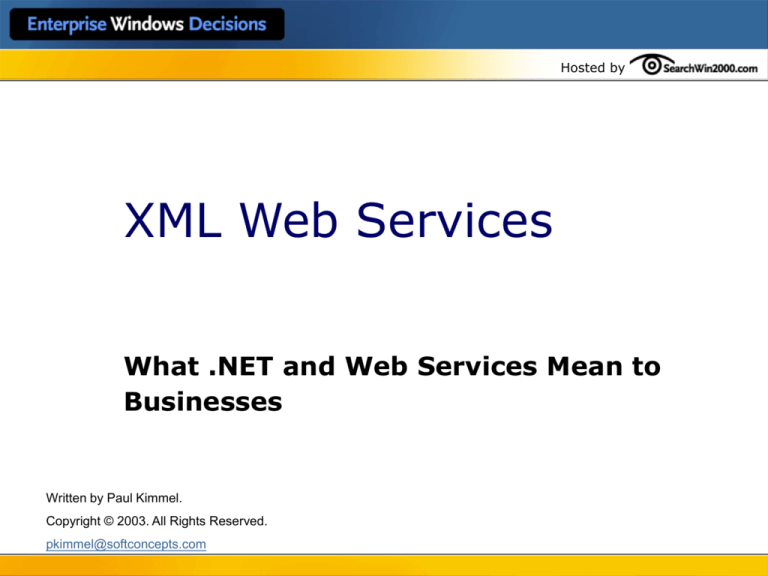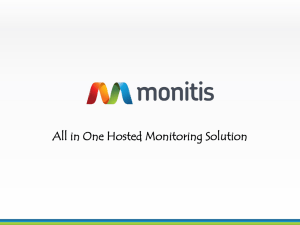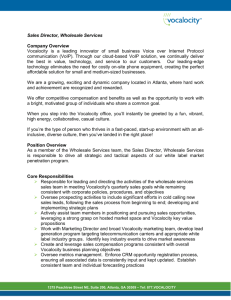
Hosted by
XML Web Services
What .NET and Web Services Mean to
Businesses
Written by Paul Kimmel.
Copyright © 2003. All Rights Reserved.
pkimmel@softconcepts.com
Hosted by
What is an XML Web Service?
Tools and technologies for moving data over a
network, especially the Internet
Based on Open Standards
Object Oriented
The only limitations are imagination
Hosted by
What Problems do Web Services Solve?
Application Integration
Simple Services
Workflow Solutions
And, more…
Hosted by
Simple Services
Offer services that solve problems for
your customers
Connect business to business services
• How much to ship a package?
• What is the cost of an airline ticket?
• When does my plane depart?
• Tickets to see the “Three Tenors”
Hosted by
Example 1: US Geological Survey
Hosted by
Close Up!
Hosted by
Workflow Solutions
Business-to-business solutions
• Customer Orders PC from Dell
•
Dell automatically verifies inventory (orders from supplier if
needed)
•
Dell assembles with supplier provided parts, keeping
inventory costs low
•
Coordinates receipt of payment with Dell Financial Services
or Credit Card vendor
•
Negotiates shipment with USPS, UPS, Airborne Express,
DHL or FedEx
•
•
Shipper notifies Dell of Delivery
•
Tracks service requests and upgrades
Notifies customer service provider (perhaps outsourcing
technical support)
Hosted by
Application Integration
Integrate legacy software with new
technology
Expose existing capabilities as Web
Services and build from there
Doesn’t require a complete rewrite
Hosted by
Example 2: Bring Present Technology
to Legacy Software
Hosted by
With XML Web Services
Hosted by
Microsoft and the .NET Framework
We already know about…
The good and the bad
Big war chest
Commitment to the customer
And , the warts and dimples
But, what we need to know…
Hosted by
Web Services and Microsoft
Does using .NET lock me into a Microsoft
solution?
And the answer is…
Hosted by
Not Locked in to Microsoft
Having the .NET framework on workstations
is no different than…
• Borland’s VCL
• Sun’s JRE
• Many machines already have these frameworks and more
• In a very real sense the .NET Framework is comprised of
DLLs; every computer has thousands already
Hosted by
No Bogeyman
There is no Microsoft bogeyman to fear,
because…
• XML Web Services are based on open standards, like
XML, SOAP, HTTP, TCP/IP
•
•
•
Any supplier can consume or produce XML and SOAP
Over TCP/IP networks
Results in a heterogeneous or homogeneous
solution; the call is yours
Hosted by
Why you want to choose .NET
Now let’s look at what Microsoft’s .NET
really is
And, what it can do for your business
Hosted by
.NET Framework
MS’ best technological product to date
• Based on standards like XML and SOAP
•
•
•
•
•
•
•
•
•
•
Visual Studio
UDDI, or Universal Description and Discovery
WSDL, or, Web Services Discovery Language
Language Agnostic
Attributes
CodeDOM
XML Serialization
Synchronous and Asynchronous Invocation
Works with ADO.NET
Security
Hosted by
Open Standards and Protocols
TCP/IP
HTTP and HTTPS
XML, markup language like HTML
SOAP, protocol for describing data
Hosted by
Visual Studio
Tremendous productivity achieved with
• Multiple object oriented languages
• Integrated database development
• Source repository integration
• UML modeling integration
• Extensibility model and macros for automating tasks
• Extensive integrated help
Hosted by
Language Agnostic
Program in any or every .NET language
C#
C++
J# .NET
VB .NET
And dozens more by third parties, all based
on the Common Language Specification
(CLS)
Hosted by
Universal Description and Discovery
Several Web Service registries (IBM,
Microsoft) (e.g. uddi.microsoft.com)
Hosted by
Web Services Discovery Language
Makes Web Services easy to find and
consume
Imports Web Service
Generates proxy class for very simple
consumption
Proxy classes support synchronous and
asynchronous invocation
Hosted by
Attributes
A technology that helps eliminate old
COM related problems
Helps with Web Services, Security, and
much more
Hosted by
CodeDOM
Code Document Object Model
A powerful tool/namespace in the framework
Can be and is used to write code generators
Generated proxy classes make MS’ Web Services
very easy to author and consume
Hosted by
XML Serialization
XML is a markup language like HTML or WML
Serialization is process of converting objectoriented data into text streams
Text is easily transmitted over the Internet (or
any TCP/IP network)
Serialization occurs on both ends, automatically
Hosted by
Synchronous and Asynchronous
Invocation
Synchronous equals call and wait
Asynchronous equals call and forget for
optimal performance
• Developers get this capability automatically
• Because asynchronous, or multithreaded behavior,
is built into the framework
•
Even for VB .NET
Hosted by
.NET Technological Advantage
All of these things add up to…
• Faster development times
• More advanced implementations
• More robust solutions and fewer bugs
• Tremendously scalable software
• Significant competitive advantage
• Greater revenue at lower cost
Hosted by
And there is much more
Remoting
COM Interop
Security Model
Reflection
Emitting
Multithreading
ASP.NET
ADO.NET
Hosted by
And still more
Tremendous third party support
Excellent training opportunities (e.g.
Developmentor and Compass Computing
Group)
More trade magazines, books, and articles
than any product in history (e.g. AddisonWesley, Sams, Wiley, Apres, codeguru.com,
InformIT, Windows Developer Magazine)
Hosted by
Summary
XML Web Services are big part of a much larger
picture
•
•
•
Open Standards; No lock in strategy for Microsoft
•
•
•
Web Services work with ADO.NET very well
•
Excellent support and training
Tremendous scalability
.NET Framework makes Web Services easy to build and
use with Microsoft tools
Asynchronous process for excellent performance
Commitments and participation from many industry
leaders
Hosted by
References
Kimmel, Paul. .NET Mobile Application
Development. Wiley: 2003.
Kimmel, Paul. Visual Basic .NET Power
Coding. Addison-Wesley: 2003.
Kimmel, Paul. Advanced C# Programming.
Osborne: 2002
Kimmel, Paul. Asynchronous Programming
in VB.NET. Windows Developer, April, 2002
pp. 53-57.
Kimmel, Paul. Asynchronous Programming
with Thread Pools. (www.codeguru.com)
VB Tech Notes, August, 2001
Kimmel, Paul. Sams Visual Basic .NET
Unleashed. Sams: 2001.



